This post may contain affiliate links. For more information, please see our affiliate policy.
The secret to delicious, quickly-cooking eggplant is just one basic ingredient and a little time. Here’s How to Salt Eggplant before cooking to draw out moisture and condense its flavor.
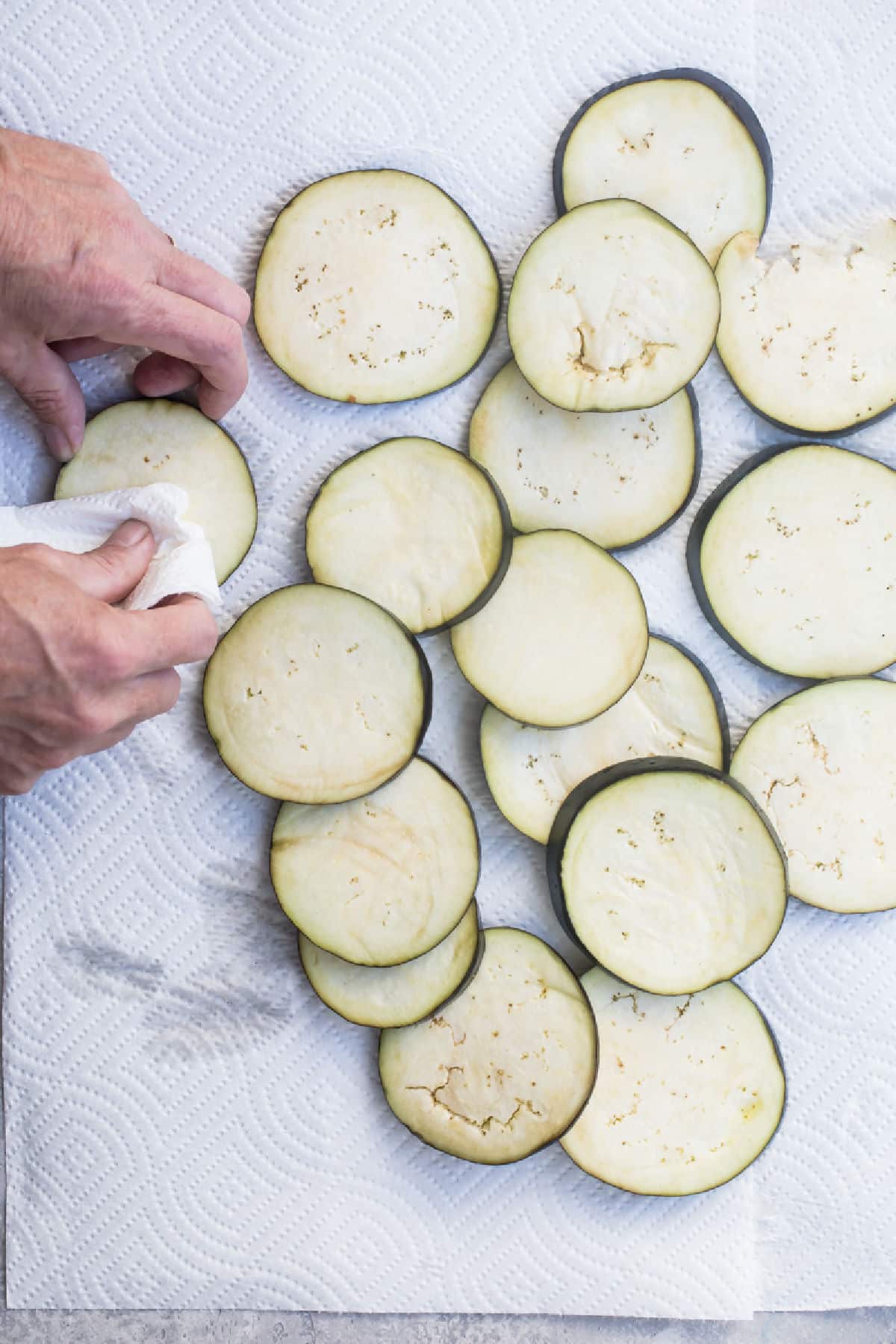
The first time you salt eggplant, you might find it tedious. Like a watched pot that never boils, step away from the salted eggplant! It will seem like nothing is happening, and then all the sudden, the cubes look smaller and darker, and you see juice in the bowl.
The magic is happening. The salt draws out the excess moisture so the eggplant has a stronger flavor and a softer, more tender texture. Sometimes cooks salt cucumbers, zucchini, and cabbage for the same reason. Less water = more flavor.
This method works for cubes, slices, and planks of eggplant.
Table of Contents
Recipe ingredients
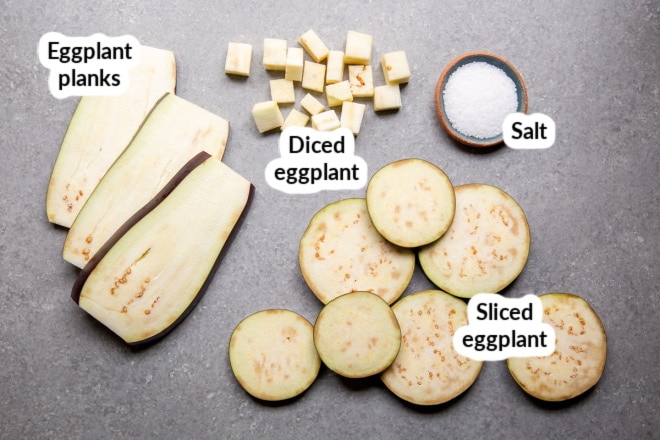
At a Glance: Here is a quick snapshot of what ingredients are in this recipe.
Please see the recipe card below for specific quantities.
Tutorial notes
- Buying: Look for an eggplant that has firm skin and has a substantial heft in your hand. Heavier fruit is a sign that the eggplant is fresh and hydrated. Avoid eggplant with any soft spots, discoloration, or wrinkling.
- Storing: Store unwashed, uncut eggplant at room temperature for up to 2 days (keep it away from other fruits and vegetables). For longer storage, wrap in a paper towel, place in a container, and store in the crisper drawer of your refrigerator for up to 5 days.
- Peeling: If the recipe calls for it, or if you want to, peel the eggplant before cutting.
- Salting: Salting removes excess liquid and some of the bitterness. Today’s eggplants are bred for mildness, though, so it’s not as important as it used to be (if you are frying eggplant, salting will ensure a creamy texture and rich flavor). This method works for eggplant slices, cubes, or planks.
- Yield: 1 pound eggplant = 6 cups cubed, raw (3 cups cooked). Serving size is about 2 cups raw, 1 cup cooked.
Step-by-step instructions
- Add the eggplant to a colander and sprinkle with salt. Toss well to coat.
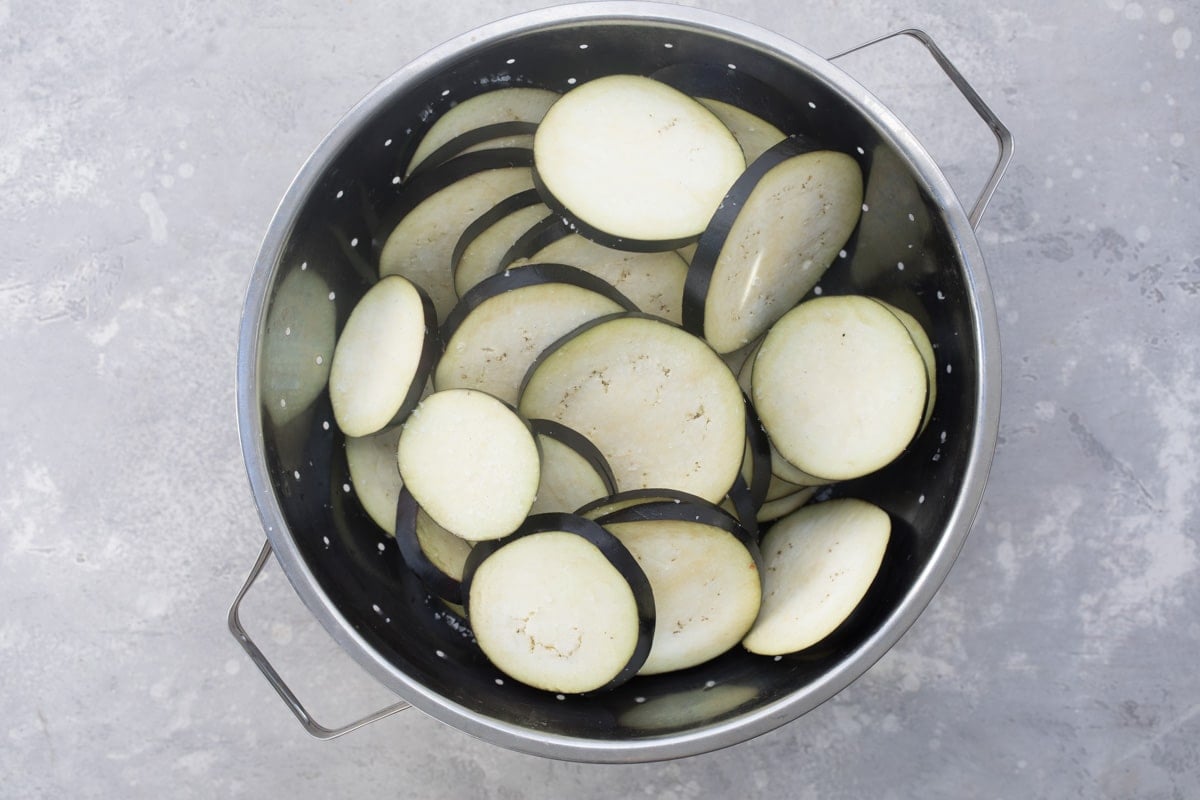
- Let sit to drain for at least 40 minutes. If salting the eggplant more than 1 hour, transfer the colander to the refrigerator.
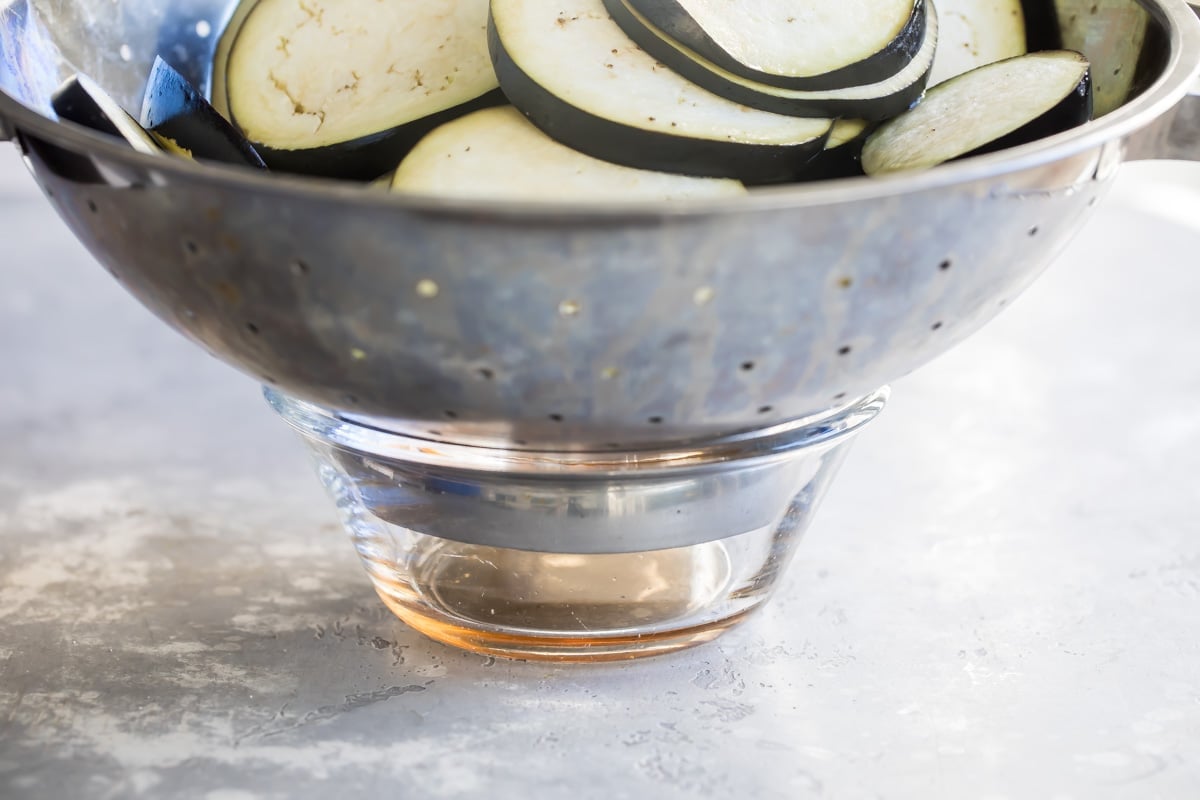
- Rinse the eggplant well, then spread on a clean kitchen towel or paper towels. Press down hard with a second kitchen towel to push out any excess liquid, as if you were pushing down on and squeezing a sponge.
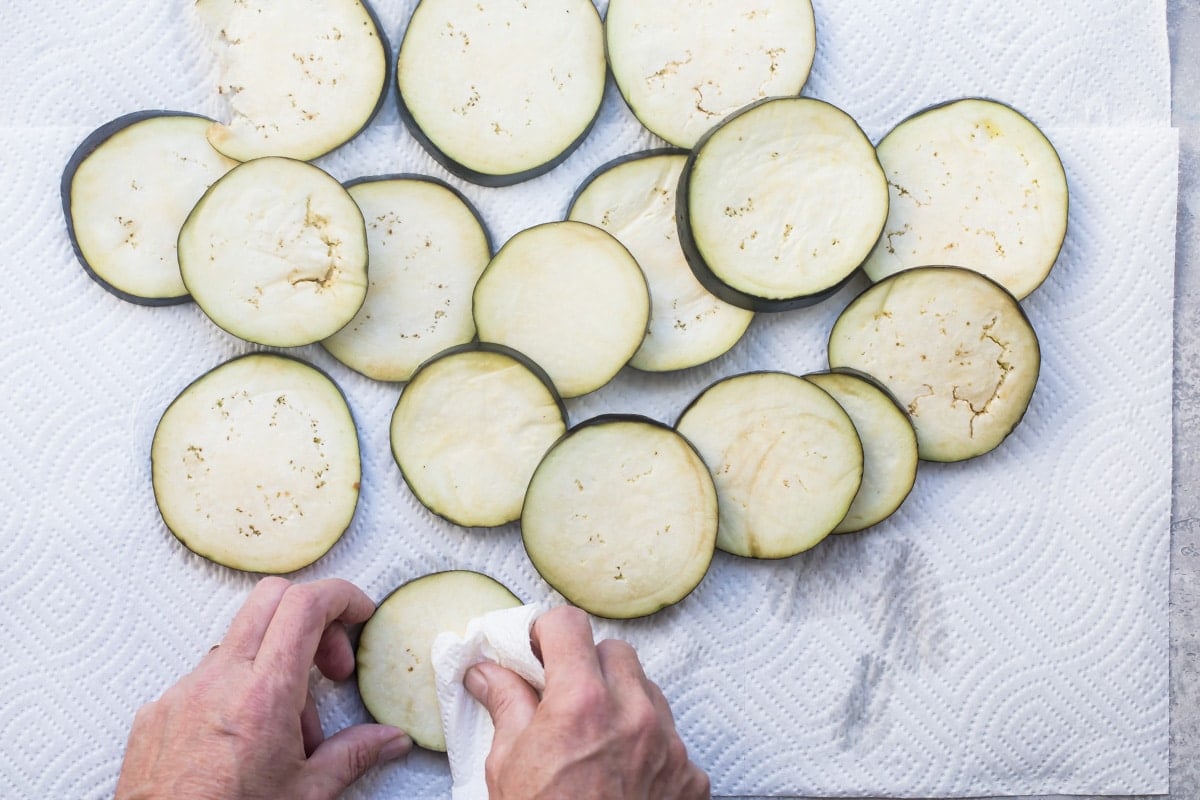
Frequently Asked Questions
Salting the eggplant before cooking draws out excess moisture so the eggplant has a stronger flavor and a softer, more tender texture. Less water = more flavor.
Eggplant does not necessarily need to be salted, but some recipes benefit from the process. If you are throwing eggplant on the grill, the excess water can drip beneath the grates as it cooks. No harm, no foul. If you think about a dish like Eggplant Parmesan, though, the extra moisture will be released during cooking which will make the bread crumb crust less crusty and the final dish more watery.
Salt your eggplant for no less than 40 minutes, but an hour or more can help reduce moisture even further.
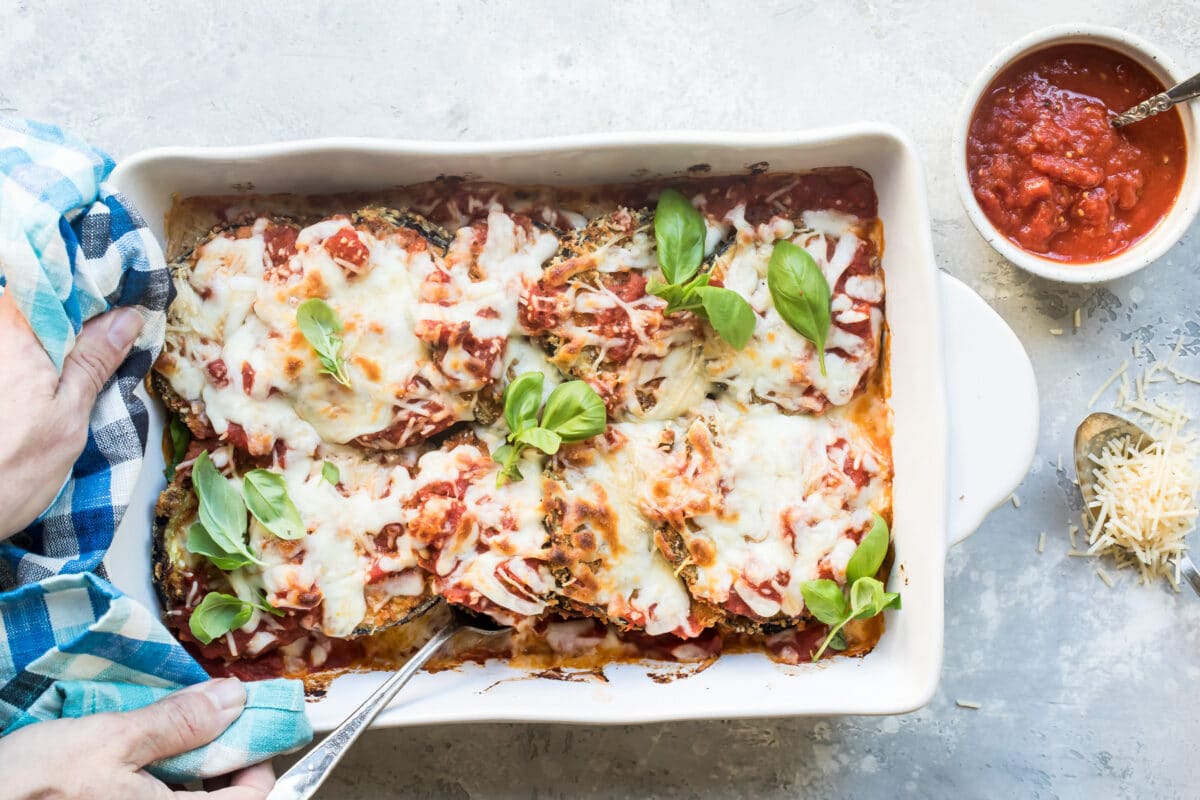
More delicious recipe ideas
Appetizer Recipes
Roasted Eggplant Dip
Italian Recipes
Vegetable Lasagna
Italian Recipes
Artichoke Pasta
Main Dishes
Stuffed Zucchini
Join Us
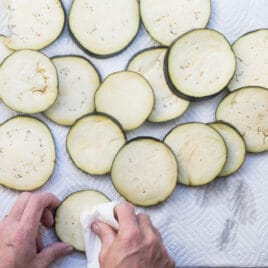
How to Salt Eggplant
Ingredients
- 2 pounds eggplant sliced or cubed, peeled if desired (about 12 cups)
- 1 tablespoon salt kosher or table salt
Instructions
- Add the eggplant to a colander and sprinkle with salt. Toss well to coat, then let sit to drain for at least 40 minutes. If salting the eggplant more than 1 hour, transfer the colander to the refrigerator.
- Rinse the eggplant well, then spread on a clean kitchen towel or paper towels. Press down hard with a second kitchen towel to push out any excess liquid, as if you were pushing down on and squeezing a sponge.
Recipe Video
Notes
- Buying: Look for an eggplant that has firm skin and has a substantial heft in your hand. Heavier fruit is a sign that the eggplant is fresh and hydrated. Avoid eggplant with any soft spots, discoloration, or wrinkling.
- Storing: Store unwashed, uncut eggplant at room temperature for up to 2 days (keep it away from other fruits and vegetables). For longer storage, wrap in a paper towel, place in a container, and store in the crisper drawer of your refrigerator for up to 5 days.
- Peeling: If the recipe calls for it, or if you want to, peel the eggplant before cutting.
- Salting: Salting removes excess liquid and some of the bitterness. Today’s eggplants are bred for mildness, though, so it’s not as important as it used to be (if you are frying eggplant, salting will ensure a creamy texture and rich flavor). This method works for eggplant slices, cubes, or planks.
- Yield: 1 pound eggplant = 6 cups cubed, raw (3 cups cooked). Serving size is about 2 cups raw, 1 cup cooked.
Nutrition
Meggan Hill is a classically-trained chef and professional writer. Her meticulously-tested recipes and detailed tutorials bring confidence and success to home cooks everywhere. Meggan has been featured on NPR, HuffPost, FoxNews, LA Times, and more.




Thank You, all of your Recipe’s and special detailed information is wonderful and much appreciated. Dianag.
Thanks Diana! – Meggan
I love your website!
One small detail…I believe we must rinse the eggplant to remove the extra salt and then pat it dry.
Hi Emily, thanks! – Meggan
Is culinary school secrets free or is there a charge to join?
Hi Sally, it’s free! – Meggan
This is how my grandma used to prepare eggplant! Thanks for showing me how!
After sweating the eggplant and patting it dry, should you salt it again?
Hi Dan, you would only add more salt if you would like it for seasoning. – Meggan
I never knew you had to do this. Thank you for teaching me the ways so I could impress my vegetarian girlfriend. 😉